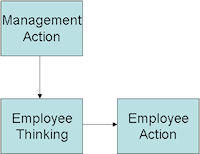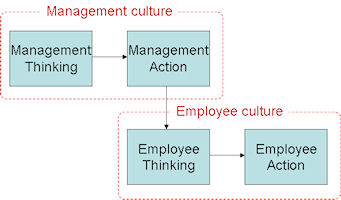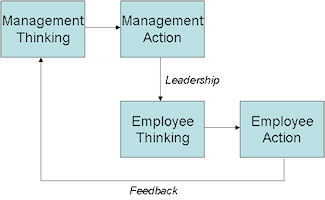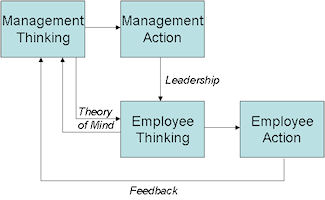
Quels sont les secrets du management à l'indienne ?
TATA' means 'management Thinking and Acting that leads to employee Thinking and Acting. This is a very simple model of organizational culture that is easy to understand and can be used to help change the culture to something more powerful.
It is often a good idea to discuss what you are going to do with the senior manager as this person's support may be important if the rest of the team start to dig their heels in during steps 3 and 4.
1. Employee Action
The easiest place to start with the top team when discussing culture is what they see and hear. Just ask them: What do you see and hear in this culture that you'd like to change?
Then stand back as they list all the things that have been frustrating them about their employees over past year or more. Typical moans include:
- People not sticking to commitments
- Lack of loyalty
- Not understanding strategic needs
- Lack of real concern for customers
- Resistance to new ideas
- Lack of creativity
...and so on. Write these down on a flipchart. If the list gets long, help them reduce it to the 'top five' (or even three).
2. Employee Thinking
Culture is not just about how people act -- it is also about attitudes, values, beliefs, mental models, emotions and so on. Next talk about this and how thinking leads to action and draw the basic cultural model:

With this you can discuss how employees think drives what they do. Again, this is simple logic that is easy to understand and accept. Depending on how rational or open the team is, you can also 'and feeling' after 'thinking'.
List the top five actions under 'employee action' and now ask the management team to list how they believe employees are thinking in ways that leads to the identified action. This is a little harder task but most managers will have few problems coming up with assumptions about what the employees may be thinking. Remind them as necessary that their employees are human and that employee thinking will make sense, at least to them.
Typical thinking could include:
What's in it for me
Do what I'm told
No point rocking the boat
Do least work for maximum pay
Keep your head down
3. Management Action
Now it starts to get more interesting and stage 3 ideas may require some discussion before you start listing. The primary principle is that a significant driver of what employees think is what managers say and do. Of course there are other forces on employees but what managers say and do has a huge effect -- sometimes more than managers may think (and if employee thinking is not affected by what managers say and do then there would be an even bigger problem).
This can be shown as below. Putting 'Management Action' above 'Employee Thinking', rather than to the left, is a subtle hint of superiority that may help managers find it easier to accept the ideas.

Now you can ask 'What are you saying and doing that is leading to what employees think?' This can be a very difficult moment for managers who do not want to accept responsibility for what employees think and do and you may need to keep the dialogue going for a while before you write anything down. You may need to press them on this, asking such as 'Are those actions really leading employees to think like that?' until you get to realistic information.
Discussions can include such as whether managers actually follow 'company values' as published, and what employees think about this. As appropriate, you can change or extend the 'Employee Thinking' box.
Ask permission, then write down the words and actions they tell you about, above the 'Management Action' box. If a longer list appears, then help them prioritise for the top three to five actions that have the greatest effect on employee thinking.
If this segment worked, there should be a significant number of 'aha's in recognizing what managers say and do affects culture and hence how it must change.
4. Management Thinking
If step 3 was difficult, then step 4 may well be even more difficult again, although it may also be easier if the penny has dropped and the principle accepted by now.
Just as employee thinking drives employee action, so also does management thinking drive management action. So the question now is 'What are your thoughts that are leading to what you say and do?' Draw in the last box as below. There should be no debate about whether this is valid as the 'Thinking - Action' principle has already been established.

Again, this may require some dialogue before you start to write things down (when you do, put them above 'Management Thinking'). The critical message is that how they think and feel is at the root of a causal chain that leads directly to what employees say and do, and hence to change the culture of the organisation they must change what and how they think - which can be a very scary subject and hence need plenty of space and support to happen.
Discussions can include questions about what they think about employees, what their values really are, and so on. In this session do not try to get it all out but just enough for them to realize how what they think is very important.
Further possibilities
This is a simple but powerful model which you can use in a number of additional ways.
Deeper stuff about thinking
From this session additional sessions can be held to explore what and how the management team thinks. If the first session has provided the wake-up call and an understanding of the importance of how they think then these sessions can be used to dig into personal and interpersonal drivers and dynamics.
Management and Employee cultures
Taking the simple 'thinking and acting' culture model, management culture and employee culture may be explored separately and reasons for differences discussed.

Influence and spirals
Management Action that changes Employee Thinking is pretty much what leadership is. A powerful discussion about leadership can therefore be had by considering this link.
An additional link may be added between Employee Action and Management Thinking. How we think is driven by what others say and do and the way managers think is often strongly affected by how employees act. This link completes a causal circle, which means there can be spirals of thinking and acting that can both improve and degrade the power of the organisation.

An interesting part of this discussion may be about how strong the Management Action - Employee Thinking link is, as compared with the Employee Action - Management Thinking link. Ideally, both exist but the biggest influence is the manager to employee direction. Sometimes management thinking is more strongly influenced by a wilful workforce and effectively the 'tail wags the dog'.
The balance of appropriate strengths between these two links depends on the industry, for example in intellectual and creative businesses a strong upward link might be a good idea. The question is to find the best balance for the business the company is in.
Theory of mind
Another area for possible exploration is in how we think others are thinking. We all use a great deal of 'theory of mind' in guessing what others are thinking and we often get it very wrong.

The question may thus be discussed about how managers think employees think and what employees think that managers think. This is a ripe topic for realizing that how you think others think is often a long way from how they are really thinking.
A session on theory of mind is best done as a facilitated dialogue between managers and employees. It is critical for this to succeed that an atmosphere of trust and openness is created.
Multiple levels
The model as presented divides simply along the 'manager-employee' line, which is often a significant cultural divide. Depending on the organisation, more than one level of analysis may be completed.
The framework can also be used to examine any connected cultural systems, for example between marketing and R&D or between the local company and headquarters.
As-is and To-be
The first session (or sessions) is about how things are at the moment and should probably be kept that way. If you have energized the team then a future session to think about how things could be different may be held.
Go through the same steps but now think about how they would like things to be. Thus ask:
What do we want employees to say and do?
So what must they think and feel that will drive this action?
So what must managers say and do to lead employees to these thoughts?
And how must managers think and feel in order that they will act in the appropriate way?
Of course the next question is, 'Now that we know where we are and where we want to go, how do we get there?' Which is a whole conversation or more.